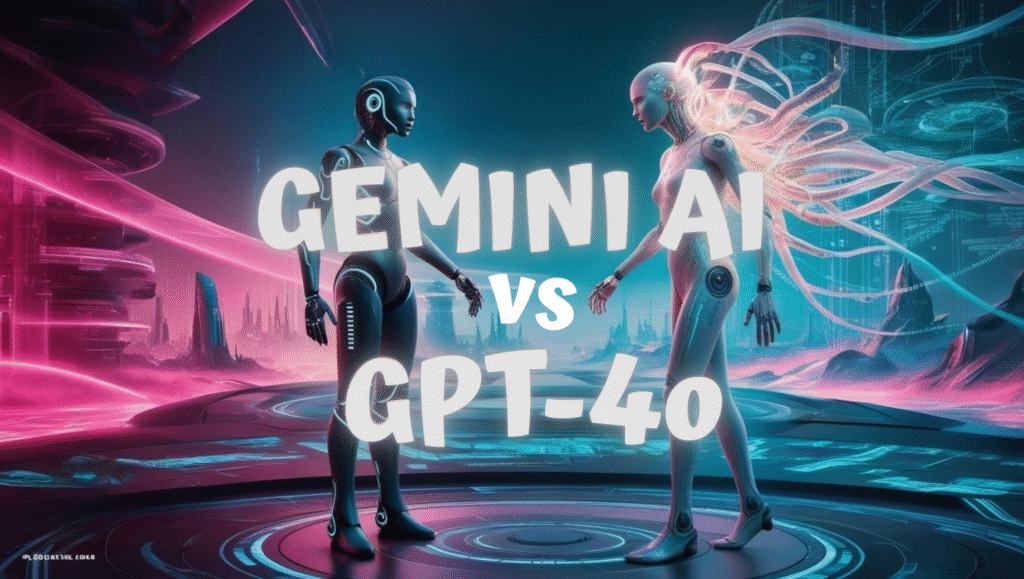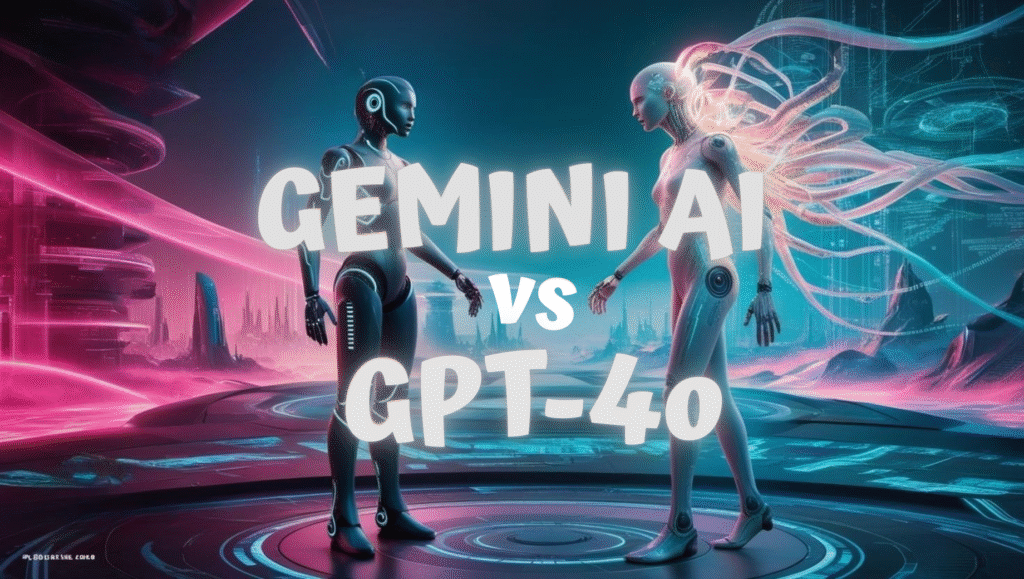Gemini AI Overview: Features and Capabilities
Gemini AI, developed by Google DeepMind, has emerged as a formidable contender in the landscape of AI technologies, particularly due to its features and capabilities that set it apart from other models like GPT-4o. This new AI powerhouse boasts a range of innovative functionalities designed to enhance user experience and versatility across multiple applications.
Key Features of Gemini AI
One of the standout aspects of Gemini AI is its advanced multimodal capabilities, allowing it to process and generate text, images, and even videos. This feature significantly elevates Gemini’s functionality compared to traditional text-based models like GPT-4o, which primarily focuses on language.
Moreover, Gemini AI employs cutting-edge reinforcement learning techniques, enabling the model to adapt and improve over time based on user interactions. This adaptive learning equips Gemini with the potential for greater accuracy and relevancy in responses, a feature that developers and end-users alike find invaluable.
Natural Language Processing Enhancements
Gemini AI showcases enhanced natural language processing (NLP) abilities, with capabilities that include better contextual understanding and improved generative responses. This allows Gemini to engage in more meaningful conversations, making it a more appealing choice for applications needing emotional intelligence and nuanced communication. While GPT-4o has made strides in these areas, Gemini’s ongoing updates signify a commitment to staying at the forefront of AI capabilities.
Integration and Usability
The ease of integration into existing systems marks another advantage of Gemini AI. With a wider array of APIs and developer tools, it allows businesses to harness its power seamlessly, thereby enhancing productivity. This contrasts with the more rigid integration requirements often associated with models like GPT-4o, making Gemini a versatile option for developers looking to implement AI solutions quickly and efficiently.
Conclusion: A Step Ahead in AI Innovation
In conclusion, the features and capabilities of Gemini AI demonstrate a significant leap in innovation within the AI space. Its advanced multimodal features, adaptive learning capabilities, and superior NLP enhancements make it a compelling choice compared to GPT-4o. As AI continues to evolve, Gemini AI’s strengths position it well for future advancements and applications across various domains.
GPT-4o Overview: Features and Capabilities
OpenAI’s GPT-4o epitomizes the next leap in AI language models, boasting several key advancements that enhance both usability and performance. As an updated iteration in the celebrated GPT series, this model highlights significant improvements over its predecessors, emphasizing versatility and efficacy in various applications.
Key Developments in GPT-4o
One of the standout features of GPT-4o is its enhanced comprehension of context and nuances in language. The model has been trained on a more extensive and diverse dataset, enabling it to generate responses that are not only contextually relevant but also richer in detail. This improvement allows for more engaging interactions, making it suitable for complex tasks ranging from customer service automation to content creation.
Additionally, GPT-4o incorporates advanced mechanisms for reasoning and maintaining coherent conversations. Previous iterations sometimes struggled with context retention over lengthy dialogues; however, GPT-4o’s design addresses these limitations. By utilizing novel training techniques, including reinforcement learning from human feedback, the model achieves better retention and focus, ensuring that users receive accurate and contextually aware responses. These updates make it a robust option for businesses looking to leverage AI for customer interaction or other conversational applications. For a deeper dive into the innovations under the hood, read this article on the features and innovations of GPT-4o.
Applications of GPT-4o
In terms of practical applications, GPT-4o can be utilized across various sectors. From enhancing educational tools, where it aids in personalized learning experiences, to supporting creative writing and marketing strategies with compelling content generation, its versatility is striking. You can explore more on how AI is revolutionizing education in our article on data-driven innovation in education.
Furthermore, GPT-4o’s architectural enhancements mean that it can integrate seamlessly with other technologies, such as APIs or existing software systems, thereby improving workflows and productivity. This is particularly relevant for businesses deploying automated chatbot solutions or content generation frameworks, as seen in discussions about ChatGPT for businesses.
Overall, the advancements in GPT-4o mark a significant step forward in the realm of generative AI, promising to deliver more sophisticated, reliable, and adaptable AI services. The ongoing developments enable it to maintain a competitive edge, not just against its predecessors but also in the rapidly evolving landscape of AI technology, including emerging models like Claude and Gemini AI. As we delve deeper into the features of Gemini AI in comparison, understanding these innovations becomes crucial in assessing future trends and capabilities in AI models.
Gemini AI vs GPT-4o Comparison: Performance and Data Handling
When evaluating the performance and data handling capabilities of Gemini AI and GPT-4o, a number of distinct factors come into play. Both models have garnered attention for their efficiency, but their approaches and results vary significantly.
Performance Metrics
In terms of raw performance, GPT-4o demonstrates a more robust ability to generate natural language responses swiftly and coherently. According to research published by OpenAI, the enhancements in processing speed with GPT-4o compared to its predecessor are staggering, often handling complex queries in less than a second. This rapid performance makes it ideal for applications requiring real-time interactions, such as chatbots and virtual assistants.
Conversely, Gemini AI shows promise in specialized tasks that benefit from its unique training data and algorithms. While it may not match GPT-4o’s sheer speed, Gemini distinguishes itself in accuracy and contextual comprehension, particularly in domains like data analysis and scientific research TechRadar. Users have noted that Gemini’s ability to analyze intricate datasets leads to deeper insights, contributing to its effectiveness in business intelligence.
Data Handling Efficiency
Data handling is another critical area where Gemini AI and GPT-4o showcase their differences. GPT-4o is optimized for a diverse array of datasets but can sometimes struggle with extremely large datasets that exceed its input limits. The model tends to generate responses based on patterns in the training data, which can affect performance if the context isn’t well established.
On the other hand, Gemini AI excels in structuring data and can manage multiple inputs more effectively without sacrificing coherence. This functionality is particularly beneficial in machine learning applications where data preprocessing is essential before analysis. Gemini’s unique architecture enables it to sort and prioritize data streams, thereby enhancing its operational efficiency in real-world applications—an advantage highlighted in analyses by Forbes.
Summary
Overall, the Gemini AI vs GPT-4o comparison shows that while GPT-4o leads in speed and general performance, Gemini’s strengths lie in its nuanced data handling and contextual analysis capabilities. Understanding these differences is critical for developers and businesses looking to implement AI solutions. For those interested in exploring other AI tools, you can check out our comprehensive guide on GPT-3.5 Turbo for further insights into AI performance.
Use Cases: Gemini AI and GPT-4o in Real-World Applications
As artificial intelligence continues to evolve, the capabilities of models like Gemini AI and GPT-4o are emerging as transformative forces in a variety of sectors. Understanding their unique strengths can provide clarity on which model may be best suited for specific tasks.
Gemini AI: Versatility Across Domains
Gemini AI showcases its versatility through applications in creative content generation, data analysis, and personalized learning experiences. For instance, in the creative sector, Gemini AI can assist writers in brainstorming ideas, structuring narratives, and refining prose. This capability is especially beneficial for professionals and students alike, looking to enhance their writing skills quickly.
In educational settings, Gemini AI can be employed to create tailored learning materials, adjusting to the pace and style of individual learners. This personalized approach not only improves engagement but also boosts retention rates. By automating administrative tasks such as grading and feedback, educators can focus more on teaching rather than logistical challenges. These advantages position Gemini AI as a powerful tool in enhancing productivity and creativity in diverse environments.
GPT-4o: Efficiency and Innovation
On the other hand, GPT-4o is recognized for its efficiency in processing large volumes of information and generating high-quality outputs across various fields. In the realm of customer service, for example, businesses leverage GPT-4o to automate inquiries, providing instant responses that enhance customer satisfaction. Its advanced natural language processing capabilities allow it to understand context, making interactions feel more human-like.
Moreover, GPT-4o excels in technical domains such as programming and software development. By assisting developers with code suggestions, debugging, and documentation, it streamlines workflow and reduces the time spent on repetitive tasks. This efficiency is crucial in fast-paced industries where time is of the essence. For more on how GPT-4o is transforming industries, check out this detailed guide.

Choosing the Right Tool
When comparing use cases, the decision between Gemini AI and GPT-4o ultimately hinges on specific needs. For creative tasks, Gemini AI offers diverse functionalities, while GPT-4o provides unmatched efficiency, particularly in more technical settings. Understanding the context in which you operate will help in selecting the most suited AI model for your particular use case. By thoughtfully integrating these advanced tools into workflows, users can significantly enhance productivity and drive innovation within their respective fields.
Conclusion: Choosing Between Gemini AI and GPT-4o for Your Needs
Selecting the right AI model for your specific needs can be a pivotal decision in both personal and professional settings. When examining the Gemini AI and GPT-4o comparison, there are a few key points to consider.
First, evaluate the intended use of the AI. If your focus is on content generation, both models offer unique strengths. Gemini AI, developed by Google, brings potent capabilities in natural language understanding and context awareness, making it particularly appealing for applications that require nuanced communication. Meanwhile, GPT-4o from OpenAI excels in creative tasks and has been recognized for its impressive ability to generate coherent and contextually rich text that can be privileged in writing, coding, and brainstorming scenarios.
Consider performance and integration with existing tools as well. GPT-4o has gained popularity for its seamless integrations across numerous platforms, thereby enhancing workflow efficiency for users. Conversely, Gemini AI may offer better integration for users who are heavily invested in the Google ecosystem, particularly with its API supporting features like Google Sheets.
Additionally, look at the community and support surrounding each option. OpenAI has a vibrant community contributing to its growth and support, while Google’s backing of Gemini AI ensures robust development and frequent updates, which is crucial for anyone relying on cutting-edge technology.
In summary, your choice between Gemini AI and GPT-4o should reflect specific needs like application intent, integration capabilities, and community preferences. For further insights into these models, consider reading about Claude vs GPT-4o or exploring other AI tools for optimizing productivity. Each decision you make can significantly shape your interactions with AI, paving the way for enhanced productivity and innovation in your work or personal endeavors.
Sources
- Digihetu – Features and Innovations of GPT-4o
- Digihetu – AI Tools for Solopreneurs: Top 5 Productivity Apps to Boost Success
- Digihetu – ChatGPT and Google Sheets
- Digihetu – Claude vs GPT-4o: The Battle of AI Titans Unleashed
- Digihetu – OpenAI Revolutionizing Education Through Data-Driven Innovation
- Digihetu – Harnessing ChatGPT: A Game Changer for Small Businesses
- Digihetu – Unlocking the Power of GPT-4o: Innovations and Applications in AI
- Forbes – Gemini vs Competitors: AI Models
- OpenAI – GPT-4o Research
- TechRadar – Gemini AI Reviews



